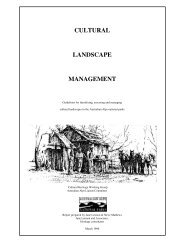Mining Heritage of the Australian Alps - Australian Alps National Parks
Mining Heritage of the Australian Alps - Australian Alps National Parks
Mining Heritage of the Australian Alps - Australian Alps National Parks
Create successful ePaper yourself
Turn your PDF publications into a flip-book with our unique Google optimized e-Paper software.
<strong>of</strong> archaeological, historic & cultural features is given higher priority than o<strong>the</strong>r management<br />
objectives in <strong>the</strong>se areas 17 .<br />
While <strong>the</strong> division <strong>of</strong> <strong>the</strong> <strong>Alps</strong> <strong>National</strong> <strong>Parks</strong> into zones with varying management priorities<br />
works at a general level, it falls down at a specific level. For instance, a rare and endangered<br />
plant species listed under <strong>the</strong> Fauna & Flora Guarantee Act that exists within an Historic Area<br />
should always receive <strong>the</strong> highest management priority. A State-significant cultural site that<br />
exists within a ‘natural’ zone should also receive <strong>the</strong> highest management priority. Assigned<br />
priorities have <strong>the</strong> potential to promote a misunderstanding that protection <strong>of</strong> <strong>the</strong> natural<br />
environment and protection <strong>of</strong> <strong>the</strong> cultural environment are somehow mutually-exclusive.<br />
5.2.5 MANAGING FLORA, FAUNA & FIRE AT HISTORIC MINING SITES/AREAS<br />
Forested settings:<br />
For mining sites in forested settings, <strong>the</strong> surrounding remnant and regrowing forest should be<br />
retained, except where significant fabric may be under threat. Interventions for protection <strong>of</strong><br />
significant fabric will generally be minor and very specific – eg removal or pruning <strong>of</strong> a tree that is<br />
pushing over a piece <strong>of</strong> machinery (poison, but never grub stumps), or a shrub that is destabilising a<br />
rock wall. The main issue for forested sites is not overall visibility, but maintaining <strong>the</strong> strong,<br />
evocative experience.<br />
Open Areas:<br />
<strong>Mining</strong> sites/areas in open settings are relatively rare within <strong>the</strong> study area, and largely confined to<br />
high areas <strong>of</strong> <strong>the</strong> nor<strong>the</strong>rn half <strong>of</strong> <strong>the</strong> Kosciusko NP, NSW, where extensive snow-grass plains exist.<br />
Even in open areas, <strong>the</strong> low, regrowing vegetation provides evidence <strong>of</strong> <strong>the</strong> abandonment <strong>of</strong> <strong>the</strong><br />
mining places, and a sense <strong>of</strong> completion. The vegetation can also assist in recognition <strong>of</strong> features.<br />
Fur<strong>the</strong>r elaboration is contained in section 5.2.6, below.<br />
All places:<br />
Non-indigenous vegetation: Guidelines for <strong>the</strong> management <strong>of</strong> exotic vegetation at cultural sites are<br />
included in Part 6 <strong>of</strong> Jane Lennon & Associates’ “Cultural Landscape Management” report (1996).<br />
At cultural heritage places, non-indigenous vegetation may occur around occupation sites, and<br />
provide important information. Such non-indigenous vegetation is not a common feature at mining<br />
sites/areas, because <strong>of</strong> <strong>the</strong> transient nature <strong>of</strong> mining and <strong>the</strong> personnel involved. Where <strong>the</strong>y occur,<br />
flowers and fruit trees around a mining hut site may indicate that it was more a ‘home’ than a hut,<br />
with extended occupation. This tells <strong>of</strong> some stability in <strong>the</strong> operation, and possibly in personnel.<br />
Non-indigenous vegetation may, however, be well developed at former mining towns within <strong>the</strong> study<br />
area, and retention is desirable within <strong>the</strong> guidelines referred to above. The spring flowering <strong>of</strong><br />
daffodils at <strong>the</strong> Kiandra cemetery is a particularly evocative example showing <strong>the</strong> value <strong>of</strong> retaining<br />
significant exotic species. Weeds can be a strong feature at mining sites, but are derivative, taking<br />
advantage <strong>of</strong> disturbed soils. Their removal is recommended where part <strong>of</strong> on-going programs, or at<br />
sites to be presented to visitors. For some vulnerable sites (eg where small artefacts abound),<br />
temporary maintenance <strong>of</strong> weed cover (particularly blackberries) can afford protection. This is not<br />
recommended as a management principle to be adopted.<br />
Fauna: Guidelines for management <strong>of</strong> animals are also given in Part 6 <strong>of</strong> Jane Lennon & Associates’<br />
report. For mining sites/areas, <strong>the</strong> principal concerns are burrowing animals (eg wombats and<br />
rabbits), which may destabilise standing machinery, rock walls, foundations etc. Because most<br />
17 Alpine <strong>National</strong> Park Management Plans (4), 1992, DCE – points rating 1-3.<br />
37

















